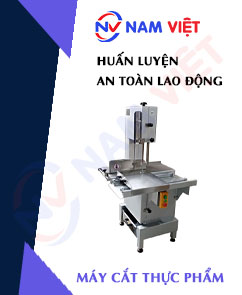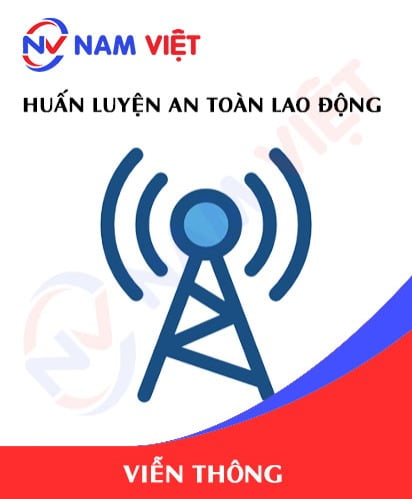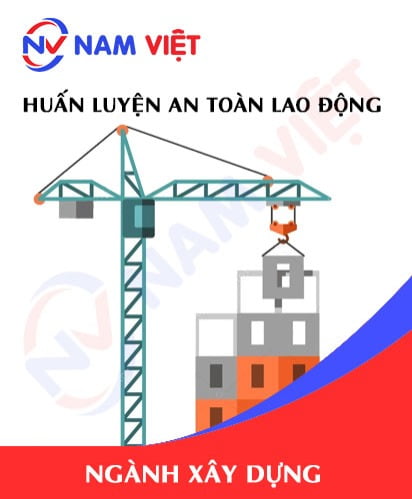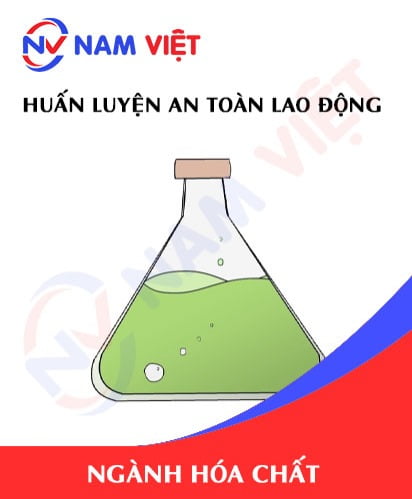Occupational Safety Training for Frozen Food Slicing Machine Operation
99,000 ₫
Note: The above price is calculated for one person and may vary depending on the number of trainees participating in the course and market fluctuations. For more accurate pricing support, please refer to the price list or contact our consulting staff directly.
Occupational safety is an important issue when operating a frozen food cutting machine and must be addressed promptly to ensure the health and safety of workers as well as enhance the reputation of businesses here. The Occupational Safety Training course is one of the effective solutions to raise awareness on preventing occupational accidents for workers when operating frozen food cutting machines.
Table of Contents
Toggle1. Overview of Frozen Food Cutting Machines
a. What is a Frozen Food Cutting Machine (Frozen Chicken Fish Meat Bone Saw Machine)?
A frozen food cutting machine is a specialized device used to cut frozen food items such as chicken, fish, beef, bones, and other food products. This machine is commonly used in food processing facilities, food factories, and meat processing establishments.
Main features of frozen food cutting machines:
- Sharp Saw Blade: The machine is equipped with a sharp saw blade, usually made from stainless steel or wear-resistant alloy, which allows easy cutting of frozen foods without compromising food quality.
- Powerful Motor: To cut through hard frozen food, the machine typically has a powerful motor to ensure stable and efficient operation.
- Adjustable Capacity: Many machines allow adjustment of slice thickness, enabling customization according to processing and production needs.
- Safety Design: Frozen food cutting machines are usually designed with safety features such as blade guards, emergency stop buttons, and protective designs to prevent accidents.
- Easy to Clean: Machines are often designed for easy disassembly and cleaning to ensure food hygiene and prolong machine lifespan.

b. Operating principle of the frozen food cutting machine
- Food Preparation: The frozen food is placed on the machine’s cutting table. The product can be secured by clamping systems or supports to ensure it does not move during cutting.
- Start the Machine: When the machine is switched on, the motor begins to rotate the saw blade. The blade may be a continuous band saw around a frame or a rotating circular blade.
- Cutting the Food: The saw blade spins at high speed and cuts through the frozen food. The blade acts as a sharp cutting tool, dividing the product into portions as required.
- Adjusting Slice Thickness: Many frozen food cutters can adjust slice thickness by changing the distance between the blade and the cutting table. This allows customization of portion size to suit needs.
- Collecting the Product: After cutting, the pieces are collected and processed or packaged as required. Frozen food cutting machines are generally designed for easy cleaning and maintenance to ensure processing occurs under hygienic conditions.
- Ensuring Safety: Throughout operation, the machine is equipped with protective features to ensure user safety. These features may include blade guards, emergency stop buttons, and other safety shields.

c. Industries that use frozen food cutting machines
Food Industry
- Meat Processing Plants: Frozen food cutting machines are used to cut large blocks of frozen meat into smaller, more manageable portions for processing. This includes chicken, beef, pork, and other meats.
- Fish Processing Plants: The machines help cut frozen blocks of fish into pieces or portions suitable for processing and packaging.
- Bone Processing Plants: For bone processing, frozen food cutting machines help cut bones into smaller segments for further processing or for producing bone-derived products.
Supermarkets and Food Retail
- Supermarkets: Frozen food cutting machines are used to cut frozen meat blocks into smaller portions or convenient retail-ready pieces for customers.
- Food Stores: Food shops, especially those specializing in meat or fish, use cutters to prepare frozen products for customers.
Restaurants and Industrial Kitchens
- Restaurants: Restaurants, especially those preparing dishes from frozen meat or fish, use frozen food cutting machines to prepare ingredients.
- Industrial Kitchens: Large-scale kitchens serving many diners use cutters to process frozen food quickly and efficiently.
Packaged Food Processing
- Food Packaging Plants: Frozen food cutting machines help cut products into specific portions or sizes before packaging and distribution.
Food Service and Catering
- Catering Services: Companies that provide food for events, conferences, and catering use cutters to prepare frozen food for large orders.
Healthcare and Research
- Research and Development: In some cases, frozen food cutting machines may be used in laboratories or food research facilities to analyze and study frozen food samples.
2. Overview of the Safety Training Course for Operating Frozen Food Cutting Machines
a. What is occupational safety training?
- Occupational safety training for operating frozen food cutting machines consists of sessions that equip workers with awareness and methods to prevent workplace accidents. Accordingly, workers who directly operate frozen food cutting machines belong to Group 3.
- The occupational safety training course helps workers recognize and avoid hazards, reducing the risk of workplace accidents during operations.
REGISTER FOR OCCUPATIONAL SAFETY TRAINING SERVICE
b. Training duration
Initial occupational safety training duration
- The total training time is at least 24 hours, including examination time.
- 8 hours of theory on the system of policies and laws on occupational safety and hygiene
- 8 hours of theory on basic knowledge of occupational safety and hygiene
- 4 hours of theory on specialized training content
- 2 hours of practical training on specialized content
- 2 hours for the final theoretical exam of the course
The safety training center will schedule the training across multiple sessions depending on worker availability. Typically, there are 6 training sessions and the course is held over 3 days, provided the manufacturing company can arrange continuous learning time.
Periodic occupational safety training duration
- Before the occupational safety card expires, if a worker wishes to renew it they must undergo the periodic occupational safety training, with the periodic training time being at least 50% of the initial training duration.
Explanation: the total time for periodic occupational safety training is at least 12 hours, including examination time. After completing the periodic course and passing the exam, the worker’s occupational safety card will be reissued/extended.
c. Course content
| No. | TRAINING CONTENT | TRAINING DURATION (HOURS) | |||
| Total | Of which | ||||
| Theory | Practice | Exam | |||
| I | System of policies and laws on occupational safety and hygiene | 8 | 8 | 0 | 0 |
| 1 | Overview of the legal and regulatory framework on occupational safety and hygiene. | 6 | 6 | ||
| 2 | System of standards and technical regulations on occupational safety and hygiene. | 1 | 1 | ||
| 3 | Specific regulations of state management agencies on occupational safety and hygiene when building new, expanding, or renovating facilities; production, use, storage and inspection of machinery, equipment, supplies, and substances with stringent occupational safety and hygiene requirements. | 1 | 1 | ||
| II | Basic knowledge of occupational safety and hygiene | 8 | 8 | 0 | 0 |
| 1 | Basic knowledge of hazards and harmful factors in the workplace. | 4 | 4 | ||
| 2 | Methods for improving working conditions. | 1 | 1 | ||
| 3 | Safety culture in production and business. | 1 | 1 | ||
| 4 | Rights and obligations of employers and employees; policies and regimes on occupational safety and hygiene for workers; functions and duties of the safety network and safety officers. | 1 | 1 | ||
| 5 | Safety and hygiene rules, signs and safety instructions, use of safety equipment and personal protective equipment; basic first aid skills for workplace accidents, prevention of occupational diseases. | 1 | 1 | ||
| III | Specialized training content | 6 | 4 | 2 | 0 |
| Comprehensive knowledge of types of machines, equipment, and substances that generate hazardous and harmful factors; analysis, assessment, and management of occupational safety and hygiene risks; safe working procedures for machines, equipment, and substances requiring stringent occupational safety and hygiene controls. | 6 | 4 | 2 | ||
| IV | Final examination of the training course | 2 | 2 | 0 | 0 |
| Total | 24 | 22 | 2 | ||
See more training contents for the 6 groups
d. Occupational safety card
After completing the occupational safety training course and passing the exam, the worker will be issued an occupational safety card (commonly referred to as the occupational safety certificate for Group 3).
The Group 3 safety card displays information such as: full name, date of birth, specific job and work environment. It also includes training duration, a red seal, and the signature confirming course completion.
According to the regulations on card issuance specified in Clause 2 of Article 24 of Decree 44/2016/NĐ-CP, there are two cases:
- If the employer and the employee have a labor contract with each other, the employer must sign, stamp, and endorse the safety card for the Group 3 trainee after they complete the training provided by an occupational safety training unit and pass the exam.
- In the case of casual or seasonal workers who do not have a labor contract, the training unit must sign, stamp, and endorse the safety card for the worker after they complete the training from the occupational safety training unit and pass the exam.

3. Hazards to Workers When Operating Frozen Food Cutting Machines
Hazards from the Saw Blade
- Severe Cuts and Hand Fractures: The sharp saw blade can cause deep cuts or hand fractures if workers are not careful or do not use protective equipment.
Hazards from the Motor
- Collision and Trapping: The powerful motor may cause collisions or trapping if not properly maintained.
Hazards from Frozen Materials
- Injuries Due to Hardness: Frozen food is very hard, which can strain hands and wrists during handling, leading to musculoskeletal injuries.
Hazards from Cleaning Chemicals
- Chemical Contact: Cleaning chemicals used to clean the machine may cause skin or eye irritation if not used and handled properly.
Hazards from Noise
- Noise Pollution: Frozen food cutting machines can produce loud noise, affecting workers’ hearing and overall health.
Hazards from Mechanical Failures
- Breakdowns and Malfunctions: Mechanical failures such as blade breakage or electrical leaks can pose dangers to workers.
Hazards from Food Movement
- Jamming or Misalignment: Food may shift or cause jams during cutting, leading to injuries if workers intervene to adjust.
Hazards from Working Conditions
- Unsafe Work Environment: Wet or slippery work environments can increase accident risks.

4. Measures to Control Occupational Accidents When Operating Frozen Food Cutting Machines
Training and Education
- Worker Training: Provide comprehensive training to workers on safe machine operation, including key procedures, troubleshooting, and accident response protocols.
- Safety Training: Train on safety regulations and procedures, use of personal protective equipment, and specific preventive measures related to cutting machines.
Use of Personal Protective Equipment
- Cut-resistant Gloves: Use cut-resistant gloves to protect hands from cuts when working near the saw blade.
- Protective Glasses: Wear safety glasses to protect eyes from debris or dust during machine operation.
- Hearing Protection: Use ear protection if noise levels exceed permissible limits.
Regular Maintenance and Inspection
- Scheduled Maintenance: Perform regular maintenance and inspections to ensure proper machine function, including checking blades, motors, and other mechanical parts.
- Pre-operation Checks: Inspect all components before operating the machine to detect potential issues early.
Safety Design and Installation
- Protective Systems: Ensure machines have blade guards, such as protective covers or automatic shut-off systems when covers are opened.
- Safe Working Area: Establish a safe working zone, including environmental controls like non-slip flooring and adequate lighting.
Safe Work Procedures
- Work Instructions: Implement safe work procedures and ensure all workers comply with these protocols.
- Warning Signs and Labels: Place clear warning signs and instructions around the cutting machine to remind workers of hazards and preventive measures.
Emergency Handling and Response
- Emergency Response Plan: Develop and implement an emergency plan that defines immediate steps and communication procedures in case of accidents.
- Incident Handling Guidance: Provide detailed instructions on how to manage machine failures or accidents.
Cleaning and Maintenance
- Machine Cleaning: Regularly clean the machine to remove dirt and debris and inspect parts for wear or damage.
- Proper Maintenance: Follow manufacturer guidelines to maintain machine performance and reduce breakdown risks.
Risk Management and Assessment
- Risk Assessment: Conduct regular risk assessments to identify potential hazards related to operating frozen food cutting machines.
- Risk Control: Develop control measures based on risk assessments to minimize accident likelihood.
Updating and Evaluating Safety Policies
- Policy Updates: Update and adjust safety policies and work procedures based on worker feedback and risk assessment outcomes.
- Effectiveness Evaluation: Evaluate the effectiveness of implemented safety measures and adjust them to improve working conditions as needed.
5. Benefits of Occupational Safety Training
An Toàn Nam Việt provides your company with the following excellent benefits upon completing occupational safety training courses in compliance with Decree 44/2016/ND-CP on occupational safety and hygiene for companies, factories, and enterprises.
- Workers can recognize potential occupational accident hazards and take preventive measures to avoid accidents.
- Your enterprise can establish risk prevention measures in production, operation, and maintenance processes.
- Reduce costs related to occupational safety incidents.
- Uninterrupted production increases labor productivity and product quality.
- Compliance with labor safety laws avoids legal risks.
- Build reputation and professionalism, thereby elevating your brand.
Nam Việt’s training courses are the solution to prevent and combat external hazards affecting individuals so they can avoid dangers leading to injuries or even death.
REGISTER FOR OCCUPATIONAL SAFETY TRAINING SERVICE
6. Customer Feedback After Completing Training Courses
An Toàn Nam Việt has many years of experience accompanying various enterprises in Vietnam generally and southern provinces particularly. This responsibility is precious to Nam Việt, so our Occupational Safety Training is increasingly professional. Our growth is motivated by positive feedback and suggestions from enterprises. Below are testimonials from partners we have served.
Hoa Dat Construction and Trading Joint Stock Company
“Nam Việt’s service has helped us greatly to simplify occupational safety and complete safety documentation for work processes. The consulting team is enthusiastic and timely in answering our questions. Five stars for Nam Việt.”
See more customer interviews after using An Toàn Nam Việt’s services
7. Training Capacity of An Toàn Nam Việt
An Toàn Nam Việt is a reputable and quality occupational safety training center in Vietnam today. Safety training sessions are continuously held at factories, plants, or construction sites nationwide (all 63 provinces).
REGISTER FOR OCCUPATIONAL SAFETY TRAINING SERVICE
Occupational Safety Training License
- An Toàn Nam Việt has been inspected and certified by the Department of Safety under the Ministry of Labor, War Invalids and Social Affairs to meet requirements for occupational safety and hygiene training. This further strengthens our capacity in occupational safety training.

Materials and Lectures
- Before safety training materials are used in occupational safety training courses, they are reviewed to ensure accuracy and effective applicability.
- Our instructors use teaching methods standardized by An Toàn Nam Việt, developed by experts in occupational safety and hygiene training to maximize knowledge absorption for learners.
Facilities
- Controlling classroom factors affecting training enhances teaching efficiency and learners’ knowledge absorption.
- Our training facilities provide spacious classrooms meeting standards for area, lighting, training equipment, etc.
8. Nationwide Reputable and Quality Safety Training Center
At An Toàn Nam Việt, we prioritize occupational safety training as a professional vocation. For us, imparting knowledge for workers to protect themselves is contributing to nation-building.
To ensure effective training, we meticulously prepare everything from tools, teaching equipment to curricula, materials, sound, and lighting.
Our occupational safety trainers are experts with many years of experience, including research on hazard identification across industries and preventive methods.
Their lectures are practical, engaging, and easy to understand for workers. These factors create a comfortable learning environment and ensure knowledge is aligned with Decree 44/2016/ND-CP.
Thus, workers grasp many hazard prevention measures and how to protect themselves, applying these appropriately in their work.
Our training center proudly offers reputable, professional occupational safety training with advantages including:
- Competitive training costs without compromising quality.
- Flexible training schedules aligned with company production.
- Fast and legal-compliant certification issuance procedures.
- Experienced trainers with many years in the profession.
- Classrooms controlled for factors improving training efficiency and learning.
- Lectures tailored to occupational safety needs in enterprises.
- Dedicated, professional service for fast, accurate customer support.

9. Additional Occupational Safety Training Materials
- Safety materials for operating frozen food cutting machines
- Occupational safety training materials set
- Occupational safety training test sets
- Occupational safety training curriculum for operating frozen food cutting machines (Frozen Chicken Fish Meat Bone Saw Machine)
- Occupational safety multiple-choice test for operating frozen food cutting machines (Frozen Chicken Fish Meat Bone Saw Machine)
10. Occupational Safety Training Activities
No comments yet















Review Occupational Safety Training for Frozen Food Slicing Machine Operation
There are no reviews yet.